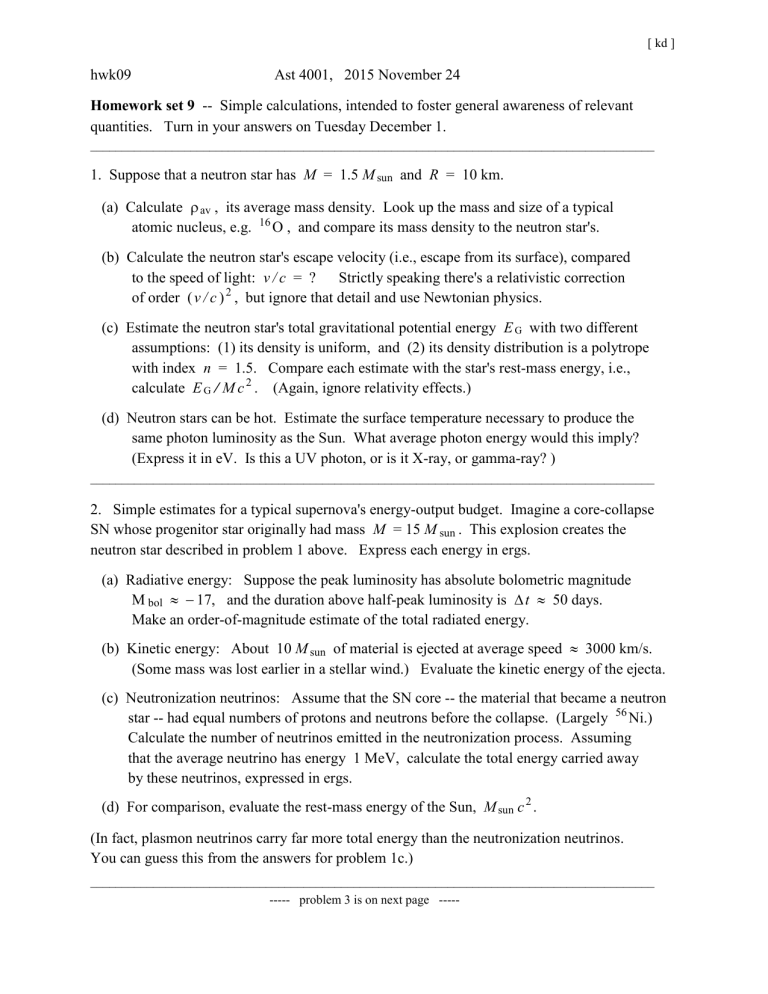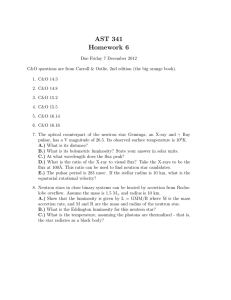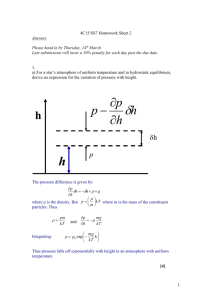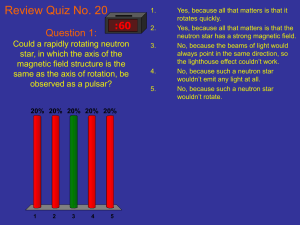hwk09

[ kd ] hwk09 Ast 4001, 2015 November 24
Homework set 9 -- Simple calculations, intended to foster general awareness of relevant quantities. Turn in your answers on Tuesday December 1.
__________________________________________________________________________________________
1. Suppose that a neutron star has M = 1.5 M sun
and R = 10 km.
(a) Calculate
av
, its average mass density. Look up the mass and size of a typical
atomic nucleus, e.g.
16
O , and compare its mass density to the neutron star's.
(b) Calculate the neutron star's escape velocity (i.e., escape from its surface), compared
to the speed of light: v / c = ? Strictly speaking there's a relativistic correction
of order ( v / c )
2
, but ignore that detail and use Newtonian physics.
(c) Estimate the neutron star's total gravitational potential energy E
G
with two different
assumptions: (1) its density is uniform, and (2) its density distribution is a polytrope
with index n = 1.5. Compare each estimate with the star's rest-mass energy, i.e.,
calculate E
G
/ M c
2
. (Again, ignore relativity effects.)
(d) Neutron stars can be hot. Estimate the surface temperature necessary to produce the
same photon luminosity as the Sun. What average photon energy would this imply?
(Express it in eV. Is this a UV photon, or is it X-ray, or gamma-ray? )
__________________________________________________________________________________________
2. Simple estimates for a typical supernova's energy-output budget. Imagine a core-collapse
SN whose progenitor star originally had mass M = 15 M
sun
. This explosion creates the neutron star described in problem 1 above. Express each energy in ergs.
(a) Radiative energy: Suppose the peak luminosity has absolute bolometric magnitude
M
bol
and the duration above half-peak luminosity is
t
50 days.
Make an order-of-magnitude estimate of the total radiated energy.
(b) Kinetic energy: About 10 M sun
of material is ejected at average speed
3000 km/s.
(Some mass was lost earlier in a stellar wind.) Evaluate the kinetic energy of the ejecta.
(c) Neutronization neutrinos: Assume that the SN core -- the material that became a neutron
star -- had equal numbers of protons and neutrons before the collapse. (Largely
56
Ni.)
Calculate the number of neutrinos emitted in the neutronization process. Assuming
that the average neutrino has energy 1 MeV, calculate the total energy carried away
by these neutrinos, expressed in ergs.
(d) For comparison, evaluate the rest-mass energy of the Sun, M sun c
2
.
(In fact, plasmon neutrinos carry far more total energy than the neutronization neutrinos.
You can guess this from the answers for problem 1c.)
__________________________________________________________________________________________
----- problem 3 is on next page -----
4001hwk09 - p2
__________________________________________________________________________________________
3. In an order-of-magnitude sense, the fundamental pulsation period of a star is fairly close to the "dynamical timescale" t
dyn
= ( G
)
, where we'll assume in this problem that
= average internal mass density. Evaluate the dynamical timescale for each of the following objects. You may need to look up most of the necessary masses and sizes, or even make intelligent guesses; in any case specify what numbers you've assumed. Express each value in an appropriate unit of time for that object:
s, ms, seconds, minutes, hours, days, months, years, or whatever fits it best.
(a) The Sun.
(b) Planet Earth.
(c) The red supergiant star
Orionis = Betelgeuse.
(d) The white dwarf star Sirius B.
(e) The neutron star described in problem 1.
(f) An interstellar giant molecular cloud with density
10
4
H-atoms per cm
3
.
(g) (This question is a little different) If the observable universe has radius
13 billion
lightyears, estimate the mass density that would give it a dynamical timescale of
13 billion years. If this density were ordinary matter, express it in baryons per cm
3
.
(In reality, as most people know, most of it is not ordinary matter.)
Calculate the total mass expressed in M sun
, pretending that it’s a sphere with
familiar Euclidian geometry.
In principle we ought to do this with a proper model, using general relativity.
But the simple Newtonian approach is surprisingly good for many cosmological
parameters.
__________________________________________________________________________________________











